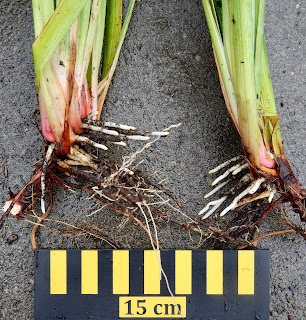The astronomical calendar has rotated into autumn: Rain and cooler weather bring mushrooms, migrating birds and salmon, and new growth for many types of irises. Here on the West Coast, it’s time to plan fall lifting, dividing, and replanting of Pacifica irises.
Wait for your plants to show fresh white roots that are at least two inches long. If you have access to irrigation water, water thoroughly a few times in September and October to help encourage Pacifica irises to break summer dormancy. Watering is needed only when replanting, and not weekly thereafter (unless it doesn’t rain for weeks and the soil dries out).
Monitor weather for rain, and wait for the soil to dampen to a depth of at least six inches (or irrigate your garden). When new iris roots emerge, start planning times to rework and plant flower beds. Better yet, consider scheduling a planting party! Along the coast, this is usually October into November.
Take time to replenish soil coverings (aka mulches), and amend soils with nutrients and carboniferous materials like compost, ramial, and biochar. Any time you dig a plant hole, add some carbon, work it into the hole, and then replant. My preferred carbon-rich materials and sequence (bottom to top) are: biochar, compost, ramial, wood chips.
Although I make my own compost, I never have enough. Ants, mice and voles haul seeds around, and seem to like dragging grass seeds and some dicots into my compost piles. If you can get it, compost from methane digesters is seed free.
When I rework beds, I layer biochar and compost over the open garden bed that is ready to replant. Then I plant into this area, working the carbon materials down and around each hole and the roots. I may also add more compost on top, below the top layers (ramial and wood chips).
Ramial is a freshly shredded blend of hardwood stems and leaves, like shrub and tree branches. During fall cleanup I shred hardwood branches before leaf fall, and put these chips out as a top dressing on garden beds. This mix breaks down easily without needing extra nitrogen, and helps boost carbon in the soil. It’s almost as good as foliar sprays for plant health. Like compost, I never have enough ramial.
Biochar is charcoal, pretreated with compost to inoculate it with microorganisms, and is usually ground into a coarse powder. It helps soils retain water and nutrients, and promotes good soil structure. It’s especially a boost for beneficial soil fungi, which helps promote healthy roots in Pacifica iris.
Perennials thrive with wood chip mulches. We have trees, which regularly need limbs removed. I chip them, and turn the resulting wood chip pile to compost. Fungal mycelia appear throughout the wood piles within a few weeks. When I add these chips to an iris bed, fungi are coming with them. Fungi are beneficial for both the soil and my plants.
If wood chips are too coarse when fresh, run them through a chipper. (NOTE: I have learned the hard way to wear a mask when chipping—my lungs do not care to inhale wood dust, fine bits of leaves, shredded fungi, or compost fragments. For extra protection, put a bandana over the top of a N95 mask. Eye protection is a good idea too.)
Fine wood chips can also be added to a compost pile. They provide a coarse source of carbon and help break down food scraps for optimal compost texture.
Other soil amendments to add to garden soils during the fall include: eelgrass, dried kelp meal, ground oyster shells, feather meal, and mineral soil amendments.
Eelgrass mats wash up on the boat ramp at the local port, which gardeners can collect. We have enough rain that we can add it to garden beds, on top of the wood chips, and know the rain will dilute the salt. Otherwise, lay the eelgrass out to compost, let rain wash the pile for a month or two, then spread it.
Winter is coming, but before that season comes fall--the best time to plant, replant and transplant on the West Coast. Enjoy the season!













